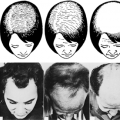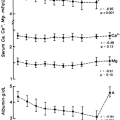THERAPY FOR HYPOCALCEMIA
Before treating hypocalcemia, one should recall that hypoalbuminemia is the most common cause of low total serum calcium concentration; it often occurs in patients with malnutrition or other debilitating diseases. In such patients, nutritional support, rather than treatment of hypocalcemia, is appropriate. If hypoalbuminemia cannot account for the observed decrease in total calcium, or if the ionized calcium level is found to be low, an evaluation and treatment of the hypocalcemia are indicated. Underlying disorders, such as hypomagnesemia or malabsorption, should be sought and corrected whenever possible.
EMERGENCY THERAPY
Urgent therapy with intravenous calcium is required for patients who have acute hypocalcemic crisis manifested by
severe tetany, laryngospasm, or convulsions. In adults, 10 to 20 mL of 10% calcium gluconate (93 mg elemental calcium per 10 mL, 4.65 mEq/10 mL) may be infused over 10 minutes. For children, 2 mg of elemental calcium per kilogram of body weight (˜0.2 mL/kg of 10% calcium gluconate) may be used. Patients who require immediate treatment for tetany and patients who have symptoms of hypocalcemia without tetany are often candidates for intravenous calcium infusion over a longer period. Elemental calcium (10–15 mg/kg) may be infused over 6 to 8 hours while serum calcium levels are monitored to assess the adequacy of the administered dose. Calcium salts are extremely irritating; therefore, care should be taken to avoid extravasation of the dose, and dilution of the calcium in at least 50 to 100 mL of electrolyte solution is recommended. Certain anions, such as bicarbonate and phosphate, cause the precipitation of calcium.
severe tetany, laryngospasm, or convulsions. In adults, 10 to 20 mL of 10% calcium gluconate (93 mg elemental calcium per 10 mL, 4.65 mEq/10 mL) may be infused over 10 minutes. For children, 2 mg of elemental calcium per kilogram of body weight (˜0.2 mL/kg of 10% calcium gluconate) may be used. Patients who require immediate treatment for tetany and patients who have symptoms of hypocalcemia without tetany are often candidates for intravenous calcium infusion over a longer period. Elemental calcium (10–15 mg/kg) may be infused over 6 to 8 hours while serum calcium levels are monitored to assess the adequacy of the administered dose. Calcium salts are extremely irritating; therefore, care should be taken to avoid extravasation of the dose, and dilution of the calcium in at least 50 to 100 mL of electrolyte solution is recommended. Certain anions, such as bicarbonate and phosphate, cause the precipitation of calcium.
LONG-TERM THERAPY
Maintenance therapy for hypoparathyroidism consists of supplemental administration of oral calcium or vitamin D, or both. Because patients with hypoparathyroidism lack the renal effects of PTH, they usually have hypercalciuria at serum calcium concentrations within the normal range.194 Therefore, the serum calcium concentration should be maintained in the range of 8 to 9 mg/dL. This is sufficiently high to prevent most symptoms of hypocalcemia and to retard the progression of cataracts, but low enough that hypercalciuria is uncommon. Nevertheless, episodes of hypercalciuria and hypercalcemia can occur even in patients who have taken stable doses of calcium and vitamin D for years. By contrast, hypercalciuria is unusual in patients with pseudohypoparathyroidism.
TREATMENT WITH CALCIUM SALTS
A relatively high dose of a calcium salt (1500–2500 mg elemental calcium as a daily supplement) is recommended to provide a level of ingested calcium that is adequate to minimize fluctuations caused by variable dietary calcium intake. Patients can also be educated to consume a consistent quantity of calcium from dietary sources each day. Calcium content differs considerably among the available oral preparations195 (see Chap. 236). Because therapy for hypoparathyroidism must be individualized to obtain a desired serum calcium level, few absolute guidelines exist for choosing one calcium salt over another. However, the patient may have a preference, and compliance can be maximized by suggesting the most tolerable dosage form. Calcium carbonate and calcium phosphate are poorly absorbed by patients with achlorhydria; optimal absorption requires that these salts be taken with meals.196
Stay updated, free articles. Join our Telegram channel

Full access? Get Clinical Tree





